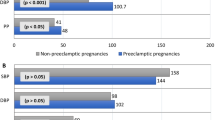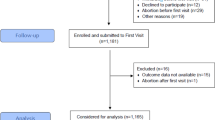Abstract
Preeclampsia is a major complication of pregnancy. Risk factors for preeclampsia include population and regional ethnicity. Chinese women living outside the Chinese mainland have a lower prevalence of preeclampsia than resident Caucasians. We performed a retrospective study to identify potential factors that may be associated with developing preeclampsia in China. A total of 67 746 pregnant women were included in this study from 2002 to 2011. Data included maternal age, maternal body mass index (BMI), age at marriage, parity, gestation and blood pressure at diagnosis, proteinuria, and birth weight. In the study period, 1301 (1.92%) nulliparous women developed preeclampsia. The prevalence of mild or severe preeclampsia was 1.42% or 0.49%, respectively. The average BMI was 21.61 kg m−2. On the basis of the WHO BMI classification, 78.8% of women were of normal BMI, 18.3% were overweight and 2.9% were obese. A total of 37.8% of preeclamptic women had lived with the same partner for less than 1 year, which was significantly higher than those healthy pregnant women who did not develop preeclampsia (24.2%). The prevalence of preeclampsia in China is low compared with Causcasians, and the contribution to this lower prevalence may be dependent on BMI or lifestyle including period of cohabitation with the partner. Our data suggest that Chinese ethnicity may be a factor responsible for the low risk of developing preeclampsia in the populations studied.
This is a preview of subscription content, access via your institution
Access options
Subscribe to this journal
Receive 12 digital issues and online access to articles
$119.00 per year
only $9.92 per issue
Buy this article
- Purchase on Springer Link
- Instant access to full article PDF
Prices may be subject to local taxes which are calculated during checkout


Similar content being viewed by others
References
Sibai B, Dekker GKupferminc M . Pre-eclampsia. Lancet 2005; 365: 785–799.
Meis PJ, Goldenberg RL, Mercer BM, Iams JD, Moawad AH, Miodovnik M et al. The preterm prediction study: risk factors for indicated preterm births. Maternal-Fetal Medicine Units Network of the National Institute of Child Health and Human Development. Am J Obstet Gynecol 1998; 178: 562–567.
Hogberg U . The World Health Report 2005: "Make every mother and child count" - Including Africans. Scand J Public Healt 2005; 33: 409–411.
Berg CJ, Atrash HK, Koonin L, MTucker M . Pregnancy-related mortality in the United States, 1987-1990. Obstet Gynecol 1996; 88: 161–167.
Duckitt KHarrington D . Risk factors for pre-eclampsia at antenatal booking: systematic review of controlled studies. BMJ 2005; 330: 565.
Korish AA . Magnesium sulfate therapy of preeclampsia: an old tool with new mechanism of action and prospect in management and prophylaxis. Hypertens Res 2012; 35: 1005–1011.
Steegers EA, von Dadelszen P, Duvekot J, JPijnenborg R . Pre-eclampsia. Lancet 2010; 376: 631–644.
Knuist M, Bonsel GJ, Zondervan H, ATreffers PE . Risk factors for preeclampsia in nulliparous women in distinct ethnic groups: a prospective cohort study. Obstet Gynecol 1998; 92: 174–178.
Sibai BM, Ewell M, Levine RJ, Klebanoff MA, Esterlitz J, Catalano PM et al. Risk factors associated with preeclampsia in healthy nulliparous women. The Calcium for Preeclampsia Prevention (CPEP) Study Group. Am J Obstet Gynecol 1997; 177: 1003–1010.
Anderson NH, Sadler LC, Stewart AW, Fyfe E, MMcCowan LM . Ethnicity, body mass index and risk of pre-eclampsia in a multiethnic New Zealand population. Aust N Z J Obstet Gynaecol 2012; 52: 552–558.
Caughey AB, Stotland NE, Washington A, EEscobar GJ . Maternal ethnicity, paternal ethnicity, and parental ethnic discordance: predictors of preeclampsia. Obstet Gynecol 2005; 106: 156–161.
Gong J, Savitz DA, Stein C, REngel SM . Maternal ethnicity and pre-eclampsia in New York City, 1995-2003. Paediatr Perinat Epidemiol 2012; 26: 45–52.
Rao AK, Daniels K, El-Sayed YY, Moshesh M, KCaughey AB . Perinatal outcomes among Asian American and Pacific Islander women. Am J Obstet Gynecol 2006; 195: 834–838.
Shen JJ, Tymkow CMacMullen N . Disparities in maternal outcomes among four ethnic populations. Ethn Dis 2005; 15: 492–497.
Lee CJ, Hsieh TT, Chiu TH, Chen KC, Lo L, MHung TH . Risk factors for pre-eclampsia in an Asian population. Int J Gynaecol Obstet 2000; 70: 327–333.
Robillard PY, Hulsey TC, Perianin J, Janky E, Miri E, HPapiernik E . Association of pregnancy-induced hypertension with duration of sexual cohabitation before conception. Lancet 1994; 344: 973–975.
Tanaka M, Jaamaa G, Kaiser M, Hills E, Soim A, Zhu M et al. Racial disparity in hypertensive disorders of pregnancy in New York State: a 10-year longitudinal population-based study. Am J Public Health 2007; 97: 163–170.
Broughton Pipkin F . Risk factors for preeclampsia. N Engl J Med 2001; 344: 925–926.
Tam CY, Hislop G, Hanley AJ, Minkin S, Boyd N, FMartin LJ . Food, beverage, and macronutrient intakes in postmenopausal Caucasian and Chinese-Canadian women. Nutr Cancer 2011; 63: 687–698.
Atallah AN, Hofmeyr G, JDuley L Calcium supplementation during pregnancy for preventing hypertensive disorders and related problems. Cochrane Database Syst Rev, 2002; CD001059.
Villar JBelizan JM . Same nutrient, different hypotheses: disparities in trials of calcium supplementation during pregnancy. Am J Clin Nutr 2000; 71: 1375S–1379SS.
Yu CK, Teoh T, GRobinson S . Obesity in pregnancy. BJOG 2006; 113: 1117–1125.
WHO Expert Consultation. Appropriate body-mass index for Asian populations and its implications for policy and intervention strategies. Lancet 2004; 363: 157–163.
Leung TY, Leung TN, Sahota DS, Chan OK, Chan LW, Fung TY et al. Trends in maternal obesity and associated risks of adverse pregnancy outcomes in a population of Chinese women. BJOG 2008; 115: 1529–1537.
Salha O, Sharma V, Dada T, Nugent D, Rutherford AJ, Tomlinson AJ et al. The influence of donated gametes on the incidence of hypertensive disorders of pregnancy. Hum Reprod 1999; 14: 2268–2273.
Robillard P, YHulsey TC . Association of pregnancy-induced-hypertension, pre-eclampsia, and eclampsia with duration of sexual cohabitation before conception. Lancet 1996; 347: 619.
Klonoff-Cohen HS, Savitz DA, Cefalo R, CMcCann MF . An epidemiologic study of contraception and preeclampsia. JAMA 1989; 262: 3143–3147.
Dekker GA, Robillard P, YHulsey TC . Immune maladaptation in the etiology of preeclampsia: a review of corroborative epidemiologic studies. Obstet Gynecol Surv 1998; 53: 377–382.
Zhang J . Partner change, birth interval and risk of pre-eclampsia: a paradoxical triangle. Paediatr Perinat Epidemiol 2007; 21 (Suppl 1): 31–35.
Fang J, Madhavan SAlderman MH . Low birth weight: race and maternal nativity—impact of community income. Pediatrics 1999; 103: E5.
Stone JL, Lockwood CJ, Berkowitz GS, Alvarez M, Lapinski RBerkowitz RL . Risk factors for severe preeclampsia. Obstet Gynecol 1994; 83: 357–361.
Odegard RA, Vatten LJ, Nilsen ST, Salvesen K, AAustgulen R . Risk factors and clinical manifestations of pre-eclampsia. BJOG 2000; 107: 1410–1416.
Author information
Authors and Affiliations
Corresponding author
Ethics declarations
Competing interests
The authors declare no conflict of interest.
Rights and permissions
About this article
Cite this article
Xiao, J., Shen, F., Xue, Q. et al. Is ethnicity a risk factor for developing preeclampsia? An analysis of the prevalence of preeclampsia in China. J Hum Hypertens 28, 694–698 (2014). https://doi.org/10.1038/jhh.2013.148
Received:
Revised:
Accepted:
Published:
Issue Date:
DOI: https://doi.org/10.1038/jhh.2013.148
Keywords
This article is cited by
-
Adipokine chemerin overexpression in trophoblasts leads to dyslipidemia in pregnant mice: implications for preeclampsia
Lipids in Health and Disease (2023)
-
Modified multiple marker aneuploidy screening as a primary screening test for preeclampsia
BMC Pregnancy and Childbirth (2022)
-
IL-17A polymorphism (rs2275913) and levels are associated with preeclampsia pathogenesis in Chinese patients
BMC Medical Genomics (2021)
-
Nesfatin-1 Promotes Proliferation, Migration and Invasion of HTR-8/SVneo Trophoblast Cells and Inhibits Oxidative Stress via Activation of PI3K/AKT/mTOR and AKT/GSK3β Pathway
Reproductive Sciences (2021)
-
Association of induced abortion with hypertensive disorders of pregnancy risk among nulliparous women in China: a prospective cohort study
Scientific Reports (2020)



